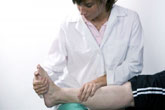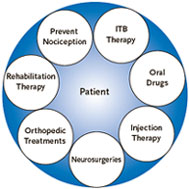 Spasticity
is considered one aspect of abnormal muscle tone that increases
muscle tone at rest and may alter the dynamic activation of a
muscle. It is characterized by increased resistance to passive
stretch, is velocity dependent and is asymmetric about joints (i.e.
greater in the flexor muscles at the elbow and the extensor muscles
at the knee) (1). Exaggerated deep tendon reflexes and clonus are
also additional manifestations (1). It is also considered a
component of Upper Motor Neuron Syndrome and its’ etiology can
include injury or disease of the brain, spinal cord, and connecting
pathways (2).
Spasticity
is considered one aspect of abnormal muscle tone that increases
muscle tone at rest and may alter the dynamic activation of a
muscle. It is characterized by increased resistance to passive
stretch, is velocity dependent and is asymmetric about joints (i.e.
greater in the flexor muscles at the elbow and the extensor muscles
at the knee) (1). Exaggerated deep tendon reflexes and clonus are
also additional manifestations (1). It is also considered a
component of Upper Motor Neuron Syndrome and its’ etiology can
include injury or disease of the brain, spinal cord, and connecting
pathways (2).
As a motor disorder, spasticity alters the activity patterns of
motor units in response to sensory and central command signals. This
leads to co-contractions, mass movements, and abnormal postural
control (3). In our practice we will often see patients with upper motor neuron lesions
who present with spasticity. Some examples of such cases can
include: cerebral vascular accident, multiple sclerosis,
Huntington’s Chorea, Parkinson’s Disease, traumatic brain injury,
spinal cord injury, Cerebral Palsy and an acquired brain injury.
 As healthcare practitioners, we play a pivotal role in assessing spasticity and with the referral process. When assessing spasticity
it is important to remember that there are other factors to consider
which can impact spasticity and therefore the reliability
measurement. These factors can include: body position, speed of
passive movement, presence of musculoskeletal changes and activity
level of patient prior to testing (4). Referral to rehab early vs. later is also vital
and can help decrease impact on soft tissues especially in the
pediatric population. The traditional step ladder approach for
treatment of spasticity involves: 1) removing noxious stimuli (e.g.
bladder distension, constipation, pressure ulcers, UTI, ingrown
toenails, etc.) 2) rehabilitation therapy 3) oral medication 4) injection therapies (phenol, botulinum toxins) 5) orthopedic surgery 6) Intrathecal Baclofen Therapy (ITB)/selective dorsal rhizotomy (SDR) (5).
As healthcare practitioners, we play a pivotal role in assessing spasticity and with the referral process. When assessing spasticity
it is important to remember that there are other factors to consider
which can impact spasticity and therefore the reliability
measurement. These factors can include: body position, speed of
passive movement, presence of musculoskeletal changes and activity
level of patient prior to testing (4). Referral to rehab early vs. later is also vital
and can help decrease impact on soft tissues especially in the
pediatric population. The traditional step ladder approach for
treatment of spasticity involves: 1) removing noxious stimuli (e.g.
bladder distension, constipation, pressure ulcers, UTI, ingrown
toenails, etc.) 2) rehabilitation therapy 3) oral medication 4) injection therapies (phenol, botulinum toxins) 5) orthopedic surgery 6) Intrathecal Baclofen Therapy (ITB)/selective dorsal rhizotomy (SDR) (5).
Various questions that should be asked when selecting the best
treatment approach are (5):
1) Is moderate to severe spasticity present?
YES: Potentially appropriate for all of the treatement options
NO: Define movement disorder and explore appropriate treatments
YES & NO: Sort out the impact of spasticity from other movement
disorders with reversible methods (e.g. oral meds, injections)
2) Is there influence of weakness?
YES: Address in therapy regime
3) Is there influence of selective motor control?
YES: Address in therapy regime
4a) Is there contribution of muscle stiffness or contracture
(non-neural components)?
YES: Address with PT/OT modalities, ortho surgery and/or injection
therapies with casting
4b)
Is there contribution of the spastic catch (neural component)?
YES: Appropriate for all spasticity treatment options
5) Is the spasticty generalized or focarelated to the clinical
problem?
Generalized: oral meds, SDR, ITB Therapy, ortho surgery
Focal: injection therapy, ortho surgery
Focal and Generalized: Usually treat generalized spasticity first,
rehab, and then address the focal spasticity if still a clinical
problem
6) Does spasticity interfere with function, care or comfort?
YES: Determine what the primary problem of the patient and/or family
is and address in therapy regime while considering other spasticity
treatment options as well.
Although there may be some advantages (e.g. maintaining muscle bulk,
helping support circulatory function, assisting with postural
control and assisting with activities of daily living) for patients
in having spasticity, it is our job as healthcare practitioners to
determine the extent of how spasticity affects our patients and to
determine what will be best for our patients in the spectrum of care
for spasticity management. Only through better clinical decision
making will we be able to help our patients achieve their functional
outcome potential.
Last revised: March 12, 2010
by
Kostandinos Tsoulfas, MD & Chai
Rasavong, MPT, MBA
References:
1) http://dictionary.webmd.com/terms/spasticity
2) Lance JW. Symposium synopsis. IN: Feldman RG, Young RR, Koela WP,
eds. Spasticity: Disorder Motor Control. Chicago: Yearbook Medical,
1980:495-494.
3) Wiesendanger M. Neurophysiological basis of spasticity. In:
Sindou M, Abbobott R, Kerevel Y, eds. Neurosurgery for Spasticity.
New York: Springer-Verlag New York Inc, 1991:19
4) Katz RT, Rymer WZ. Spastic hypertonia: mechanisms and
measurement. Arch Phys Med Rehab. 1989;70(2):144-155.
5) http://professional.medtronic.com/downloads/itb/new-center-kit.pdf


 Spasticity
is considered one aspect of abnormal muscle tone that increases
muscle tone at rest and may alter the dynamic activation of a
muscle. It is characterized by increased resistance to passive
stretch, is velocity dependent and is asymmetric about joints (i.e.
greater in the flexor muscles at the elbow and the extensor muscles
at the knee) (1). Exaggerated deep tendon reflexes and clonus are
also additional manifestations (1). It is also considered a
component of Upper Motor Neuron Syndrome and its’ etiology can
include injury or disease of the brain, spinal cord, and connecting
pathways (2).
Spasticity
is considered one aspect of abnormal muscle tone that increases
muscle tone at rest and may alter the dynamic activation of a
muscle. It is characterized by increased resistance to passive
stretch, is velocity dependent and is asymmetric about joints (i.e.
greater in the flexor muscles at the elbow and the extensor muscles
at the knee) (1). Exaggerated deep tendon reflexes and clonus are
also additional manifestations (1). It is also considered a
component of Upper Motor Neuron Syndrome and its’ etiology can
include injury or disease of the brain, spinal cord, and connecting
pathways (2). 




